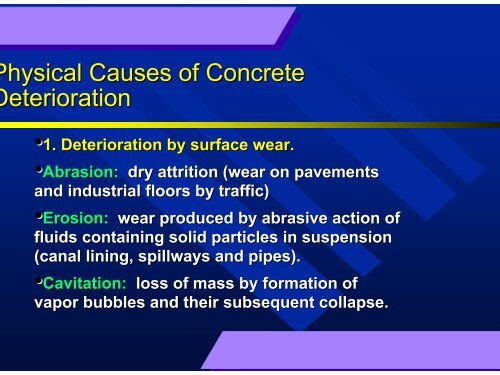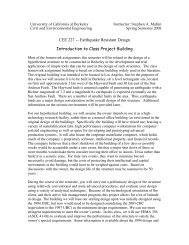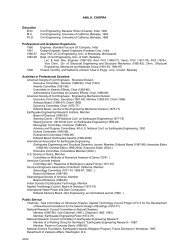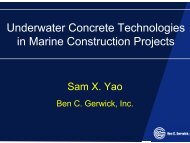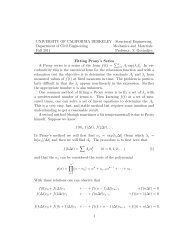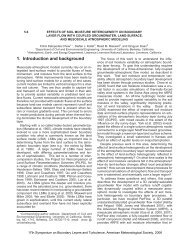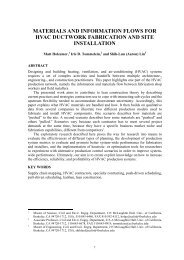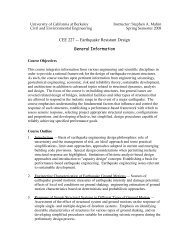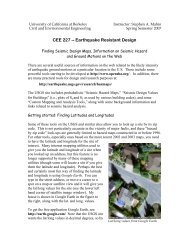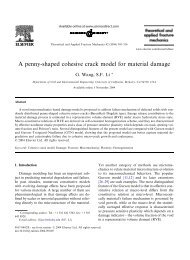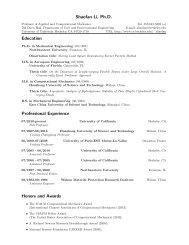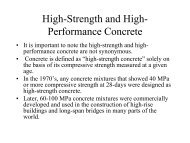Physical Causes of Concrete Deterioration
Physical Causes of Concrete Deterioration
Physical Causes of Concrete Deterioration
Create successful ePaper yourself
Turn your PDF publications into a flip-book with our unique Google optimized e-Paper software.
hysical <strong>Causes</strong> <strong>of</strong> <strong>Concrete</strong><br />
eterioration<br />
•1. <strong>Deterioration</strong> by surface wear.<br />
•Abrasion:<br />
dry attrition (wear on pavements<br />
and industrial floors by traffic)<br />
•Erosion:<br />
wear produced by abrasive action <strong>of</strong><br />
fluids containing solid particles in suspension<br />
(canal lining, spillways and pipes).<br />
•Cavitation: loss <strong>of</strong> mass by formation <strong>of</strong><br />
vapor bubbles and their subsequent collapse.
asion - Erosion<br />
•Note: the deterioration starts at the surface,<br />
therefore special attentions should be given<br />
to quality <strong>of</strong> the concrete surface.<br />
•Avoid laitance (layer <strong>of</strong> fines from cement and<br />
aggregate).
avitation<br />
•Good-quality concrete shows excellent resistance to<br />
steady high-velocity flow <strong>of</strong> clear water; however<br />
nonlinear flow at velocities exceeding 40 ft/sec. may<br />
cause severe erosion <strong>of</strong> concrete due to cavitation.<br />
•Note: In contrast with erosion or abrasion, a strong<br />
concrete may not necessarily be effective in preventing<br />
damage due to cavitation. . Solution = eliminate the<br />
causes <strong>of</strong> cavitation (review hydraulic design such as<br />
surface misalignments or abrupt change <strong>of</strong> slope).
. Cracking by crystallization <strong>of</strong> salts<br />
pores<br />
•The crystallization <strong>of</strong> salts in the pores <strong>of</strong><br />
concrete can produce stresses that may<br />
damage the concrete structure. This can<br />
happen when the concentration <strong>of</strong> the solute<br />
(c) exceeds the saturation concentration (Cs).<br />
Higher C/Cs ratio (degree <strong>of</strong> supersaturation)<br />
produces higher crystallization pressure.
. <strong>Deterioration</strong> by Frost Action<br />
•When water freezes, there is an expansion <strong>of</strong><br />
9%. However, some <strong>of</strong> the water may migrate<br />
through the boundary, decreasing the<br />
hydraulic pressure.<br />
•Hydraulic pressure depends on: (a) rate at<br />
which ice is formed. (b) permeability <strong>of</strong> the<br />
material. (c) distance to an "escape<br />
boundary."
Ice Formation in <strong>Concrete</strong>
The problem<br />
transformation <strong>of</strong> ice from liquid water generates a volumetric<br />
tion <strong>of</strong> 9%. If the transformation occurs in small capillary pores, the<br />
crystals can damage the cement paste by pushing the capillary<br />
lls and by generating hydraulic pressure.
The solution<br />
Air voids can provide an effective escape boundary to reduce this pre
Air-Entraining
Degree <strong>of</strong> Saturation
Degree <strong>of</strong> Saturation
Degree <strong>of</strong> Saturation
Low-temperature SEM
Images
Images
Dynamics <strong>of</strong> Ice Propagation<br />
Change <strong>of</strong> phase<br />
interface<br />
T c<br />
Th<br />
Temperature pr<strong>of</strong>ile<br />
in the microslide<br />
Coverslip<br />
Sample<br />
Microslide<br />
T c<br />
Base<br />
Th<br />
Base<br />
T c<br />
V<br />
Th<br />
Base<br />
d<br />
Microslide<br />
Base<br />
Fig. 56
Imagens<br />
Interface gelo-líquido em água<br />
pura
Interface gelo-líquido em<br />
solução de 0.7M Ca(OH) 2
Interface gelo-líquido em<br />
solução de 0.085M CaCl 2
Interface gelo-líquido em<br />
solução de 0.7M NaOH
Interface gelo-líquido em<br />
solução de 0.7M KOH
Freezing <strong>of</strong> concrete
Does the t<br />
air void increases or<br />
decreases when ice forms?
.1 Frost Action on Aggregate<br />
Aggregates are also porous bodies: (a) size <strong>of</strong> the pores. (b) number <strong>of</strong><br />
ores. (c) continuity <strong>of</strong> pores.<br />
There are three classes <strong>of</strong> aggregate<br />
(1) Low permeability and high strength: No problem! The rock is strong<br />
nough to support the hydraulic pressure.<br />
(2) Intermediate permeability: Potential depending on (a) rate <strong>of</strong> temperature<br />
rop. (b) distance the water must travel to find an escape boundary<br />
-- Critical<br />
ggregate Size (a large aggregate may cause damage but smaller particles p<br />
on't).<br />
(3) high permeability: May cause problem with the transition zone.
.2 Factors Controlling Frost<br />
esistance <strong>of</strong> <strong>Concrete</strong><br />
•(A) Air entrainment = void spacing <strong>of</strong> order <strong>of</strong> 0.1 to 0.2<br />
mm<br />
MSA (in) air content (%)<br />
3/8<br />
1/2<br />
3/4<br />
1<br />
2<br />
3<br />
7.5<br />
7<br />
6<br />
6<br />
5<br />
4.5
B) ) Water / Cement ratio and curing.<br />
•**Figure
C) ) Strength. No direct relationship<br />
etween strength and durability.<br />
•Example: air-entrained concrete durability<br />
(increase) strength (decrease)
. Types <strong>of</strong> frost action damage in<br />
oncrete:<br />
•4.1) Scaling: breaking away a small flat flake<br />
from the surface
.2) D-CrackingD<br />
•Aggregate problem! Appearance <strong>of</strong> fine<br />
parallel cracks along transverse and<br />
longitudinal joints and free edges <strong>of</strong><br />
pavements.
. <strong>Deterioration</strong> by fire<br />
•<strong>Concrete</strong> is able to retain sufficient strength<br />
for a reasonably long time.
.1) Effect <strong>of</strong> High Temperature on<br />
ement Paste<br />
•(a) degree <strong>of</strong> hydration<br />
•(b) moisture state<br />
•de-hydration:<br />
•ettringite<br />
> 1000C<br />
•Ca(OH)2 500-6000C<br />
•CSH ~ 9000C
.2) Effect <strong>of</strong> High Temperature on<br />
ggregate<br />
•Siliceous quartz: 573 C --sudden volume<br />
change (α(<br />
α −β quartz)<br />
•Carbonate: MgCO3 > 700 C, CaCO3 > 900 C
.3) Effect <strong>of</strong> High Temperature on<br />
oncrete<br />
•Note: unstressed concrete


